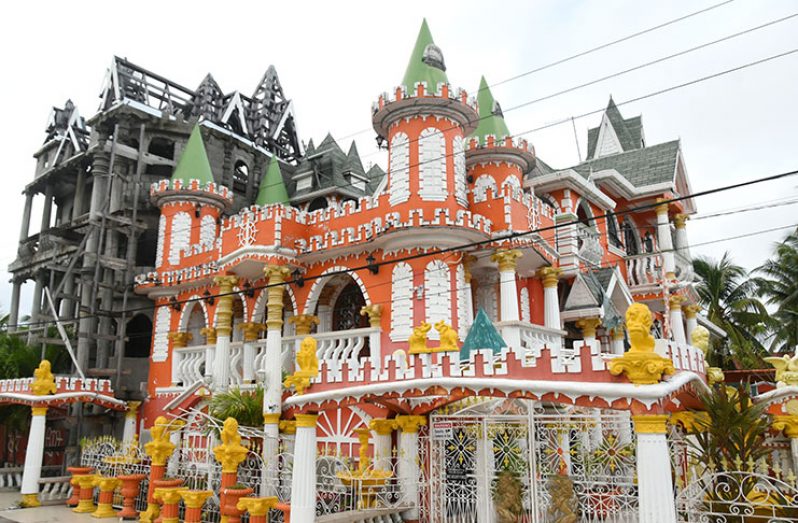IN THE MIDST of a modest neighbourhood, an exceptional haven stands in a brilliant glow even as the sun goes down upon the village of Annandale, on the East Coast Demerara corridor.
It is the peach palace, which some would say is the single most outstanding architecture along the low coastal plain which is occupied by hundreds of thousands of Guyanese. It nestles on Ram Singh Street, a ribbon corridor in a pleasing environment.
When Pepperpot Magazine visited the home which has become a tourist attraction in the 16 years since it has been constructed, it was indeed a beauty to behold.
Intricate designs stained in peach and gold and green and white, make up the perpendicular stature which carries several small peaks to signal its limitation in height. A massive unfinished addition was evident but made a pleasant compliment to the brightly coloured structure.
The owner of the fairytale castle told Pepperpot he became the architect of the masterpiece in pursuit of his childhood dream of living in one – a kind of luxury which was given to families of a royal kind. He had seen some of the buildings before with his naked eyes during travels around the world.
Being imaginative and with a deep love for creative arts, Harry Seepersaud said: “I draw it out before and then I put it on paper. Actually I am the contractor there too. No professional contractor ever worked on the building.”
He had never formally been educated in either architecture or any other form of construction but had learned drawing of structures in technical drawing class at secondary school.
He hired ordinary men with basic skills in an effort to demonstrate that getting it done was possible without the use of experts. This was after failed attempts at getting agreement from certified contractors for constructing his home the way he wanted.
“It’s an imagination. I always wanted to build something different from buildings that we see. A lot of contractors came, I give them the job (but) they always choose the easiest way out. And I take some regular people and get the job done and I show them how it can be done. Once they have basic skills I direct them how to go about doing things,” Seepersaud told this magazine.
He said he enjoyed working on the building’s design and played purely with his perfect ideas. He does not have much interest in designing other people’s homes because in doing so “you are not allowed full reign like your own. Their way is not always the best way.”
The building is complete with many of the fine amenities a castle affords but minus some of those which are designed for specific defensive purposes such as the curtain walls and arrow slits.
Wikipedia defined a palace as “a grand residence, especially a royal residence, or the home of a head of state or some other high-ranking dignitary.”
The website said in many parts of Europe, the term is also applied to ambitious private mansions of the aristocracy, with many of the historic constructions now being used also as parliaments, museums, hotels or office buildings. The word is also sometimes used to describe a lavishly ornate building used for public entertainment or exhibitions
The website defines a castle as “type of fortified structure built in Europe and the Middle East during the Middle Ages by European nobility… the private fortified residence of a lord or noble.”
Seepersaid said his first design of the palace was complete more than ten years ago, but he recently began another massive addition to the dream home.
“The first part of the building took about five years to complete. Now I am in the process of painting it up. I’m doing a little extension to it. Hopefully if all goes well, I will finish by this year end,” he proudly stated.
On the inside he said is a true reflection of a palace and has five spiral stairways to take residents to various compartments on the upper stories.
“Inside I have much more detail work than the outside. In that home carry five steps, and it is all spiral steps. It has a bunch of verandahs.”
And all around the fence and the exterior walls are dotted with neatly carved cement fountains and cemented things such as lions, elephants and mini human statues, in a complimentary botanical environment.




.png)









